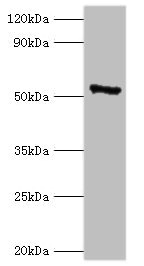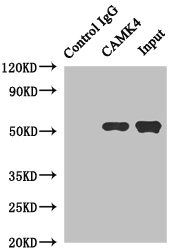
Western blot All lanes: CAMK4 antibody at 2microg/ml + 293T whole cell lysate Secondary Goat polyclonal to rabbit IgG at 1/10000 dilution Predicted band size: 52 kDa Observed band size: 52 kDa
CAMK4 Antibody

CSB-PA614976ESR2HU
ApplicationsImmunoPrecipitation, Western Blot, ELISA
Product group Antibodies
ReactivityHuman
TargetCAMK4
Overview
- SupplierCusabio
- Product NameCAMK4 Antibody
- Delivery Days Customer20
- ApplicationsImmunoPrecipitation, Western Blot, ELISA
- CertificationResearch Use Only
- ClonalityPolyclonal
- ConjugateUnconjugated
- FormulationLiquid
- Gene ID814
- Target nameCAMK4
- Target descriptioncalcium/calmodulin dependent protein kinase IV
- Target synonymsbrain Ca(2+)-calmodulin-dependent protein kinase type IV; brain Ca++-calmodulin-dependent protein kinase type IV; calcium/calmodulin-dependent protein kinase type IV; calcium/calmodulin-dependent protein kinase type IV catalytic chain; CAM kinase- GR; CAM kinase IV; caMK; CaMK IV; CaMK-GR; CaMKIV
- HostRabbit
- IsotypeIgG
- Protein IDQ16566
- Protein NameCalcium/calmodulin-dependent protein kinase type IV
- Scientific DescriptionCalcium/calmodulin-dependent protein kinase that operates in the calcium-triggered CaMKK-CaMK4 signaling cascade and regulates, mainly by phosphorylation, the activity of several transcription activators, such as CREB1, MEF2D, JUN and RORA, which play pivotal roles in immune response, inflammation, and memory consolidation. In the thymus, regulates the CD4+/CD8+ double positive thymocytes selection threshold during T-cell ontogeny. In CD4 memory T-cells, is required to link T-cell antigen receptor (TCR) signaling to the production of IL2, IFNG and IL4 (through the regulation of CREB and MEF2). Regulates the differentiation and survival phases of osteoclasts and dendritic cells (DCs). Mediates DCs survival by linking TLR4 and the regulation of temporal expression of BCL2. Phosphorylates the transcription activator CREB1 on \\\Ser-133\\\ in hippocampal neuron nuclei and contribute to memory consolidation and long term potentiation (LTP) in the hippocampus. Can activate the MAP kinases MAPK1/ERK2, MAPK8/JNK1 and MAPK14/p38 and stimulate transcription through the phosphorylation of ELK1 and ATF2. Can also phosphorylate in vitro CREBBP, PRM2, MEF2A and STMN1/OP18.
- ReactivityHuman
- Storage Instruction-20°C or -80°C
- UNSPSC12352203

